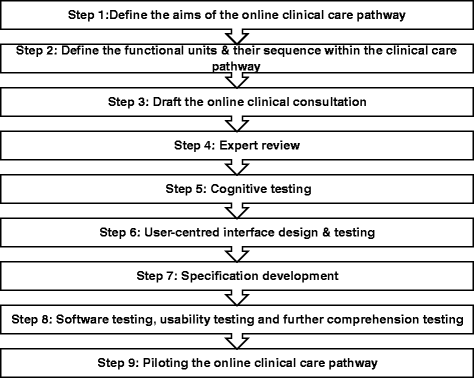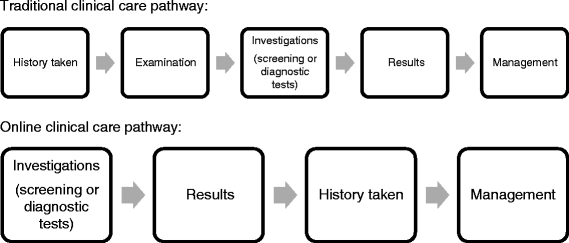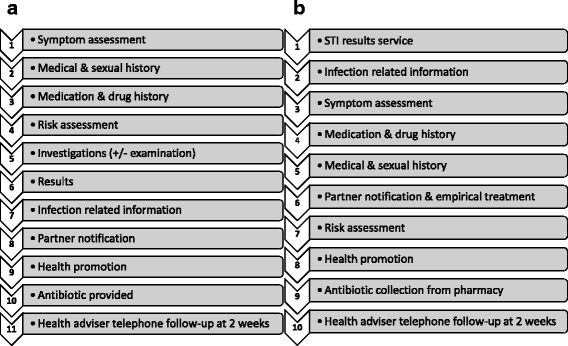The eClinical Care Pathway Framework: a novel structure for creation of online complex clinical care pathways and its application in the management of sexually transmitted infections
- PMID: 27448797
- PMCID: PMC4957844
- DOI: 10.1186/s12911-016-0338-8
The eClinical Care Pathway Framework: a novel structure for creation of online complex clinical care pathways and its application in the management of sexually transmitted infections
Abstract
Background: Despite considerable international eHealth impetus, there is no guidance on the development of online clinical care pathways. Advances in diagnostics now enable self-testing with home diagnosis, to which comprehensive online clinical care could be linked, facilitating completely self-directed, remote care. We describe a new framework for developing complex online clinical care pathways and its application to clinical management of people with genital chlamydia infection, the commonest sexually transmitted infection (STI) in England.
Methods: Using the existing evidence-base, guidelines and examples from contemporary clinical practice, we developed the eClinical Care Pathway Framework, a nine-step iterative process. Step 1: define the aims of the online pathway; Step 2: define the functional units; Step 3: draft the clinical consultation; Step 4: expert review; Step 5: cognitive testing; Step 6: user-centred interface testing; Step 7: specification development; Step 8: software testing, usability testing and further comprehension testing; Step 9: piloting. We then applied the Framework to create a chlamydia online clinical care pathway (Online Chlamydia Pathway).
Results: Use of the Framework elucidated content and structure of the care pathway and identified the need for significant changes in sequences of care (Traditional: history, diagnosis, information versus Online: diagnosis, information, history) and prescribing safety assessment. The Framework met the needs of complex STI management and enabled development of a multi-faceted, fully-automated consultation.
Conclusion: The Framework provides a comprehensive structure on which complex online care pathways such as those needed for STI management, which involve clinical services, public health surveillance functions and third party (sexual partner) management, can be developed to meet national clinical and public health standards. The Online Chlamydia Pathway's standardised method of collecting data on demographics and sexual behaviour, with potential for interoperability with surveillance systems, could be a powerful tool for public health and clinical management.
Keywords: Chlamydia trachomatis; Framework; Online clinical care pathway; Sexual health; Sexually transmitted infections; eHealth.
Figures
Similar articles
-
Young people's perceptions of smartphone-enabled self-testing and online care for sexually transmitted infections: qualitative interview study.BMC Public Health. 2016 Sep 13;16(1):974. doi: 10.1186/s12889-016-3648-y. BMC Public Health. 2016. PMID: 27624633 Free PMC article.
-
The eSexual Health Clinic system for management, prevention, and control of sexually transmitted infections: exploratory studies in people testing for Chlamydia trachomatis.Lancet Public Health. 2017 Apr;2(4):e182-e190. doi: 10.1016/S2468-2667(17)30034-8. Epub 2017 Mar 18. Lancet Public Health. 2017. PMID: 29253450
-
Can remote STI/HIV testing and eClinical Care be compatible with robust public health surveillance?DH15 (2015). 2015 May 18:129-130. doi: 10.1145/2750511.2750517. DH15 (2015). 2015. PMID: 26742547 Free PMC article.
-
Improving sexual health through partner notification: the LUSTRUM mixed-methods research Programme including RCT of accelerated partner therapy.Southampton (UK): National Institute for Health and Care Research; 2024 Mar. Southampton (UK): National Institute for Health and Care Research; 2024 Mar. PMID: 38530912 Free Books & Documents. Review.
-
Sexually transmitted infections. Genital chlamydia: practical management in primary care.J Fam Health Care. 2005;15(1):19-21. J Fam Health Care. 2005. PMID: 15819362 Review.
Cited by
-
Impact of Individual, Organizational, and Technological Factors on the Implementation of an Online Portal to Support a Clinical Pathway Addressing Psycho-Oncology Care: Mixed Methods Study.JMIR Hum Factors. 2021 Apr 14;8(2):e26390. doi: 10.2196/26390. JMIR Hum Factors. 2021. PMID: 33851926 Free PMC article.
-
The Current and Future Use of Telemedicine in Infectious Diseases Practice.Curr Infect Dis Rep. 2019 Oct 19;21(11):41. doi: 10.1007/s11908-019-0697-2. Curr Infect Dis Rep. 2019. PMID: 31630276 Review.
-
Mixed-methods evaluation of a novel online STI results service.Sex Transm Infect. 2018 Dec;94(8):622-624. doi: 10.1136/sextrans-2017-053318. Epub 2018 Jan 11. Sex Transm Infect. 2018. PMID: 29326179 Free PMC article.
-
Help-seeking for genitourinary symptoms: a mixed methods study from Britain's Third National Survey of Sexual Attitudes and Lifestyles (Natsal-3).BMJ Open. 2019 Oct 30;9(10):e030612. doi: 10.1136/bmjopen-2019-030612. BMJ Open. 2019. PMID: 31666264 Free PMC article.
-
Using the eSexual Health Clinic to access chlamydia treatment and care via the internet: a qualitative interview study.Sex Transm Infect. 2018 Jun;94(4):241-247. doi: 10.1136/sextrans-2017-053227. Epub 2017 Oct 7. Sex Transm Infect. 2018. PMID: 28988193 Free PMC article.
References
-
- England NHS. Putting Patients First: The NHS England business plan for 2013/4–2015/6. 2013.
-
- England NHS. NHS Commissioning Board launches library of NHS-reviewed phone apps to keep people healthy. 12-3-2013. 24-6-2013. http://www.england.nhs.uk/2013/03/12/nhs-apps/.
-
- England NHS . Safer hospitals, safer wards: achieving an integrated digital care record. 2013. pp. 1–7.
Publication types
MeSH terms
Grants and funding
LinkOut - more resources
Full Text Sources
Other Literature Sources
Medical
Miscellaneous




